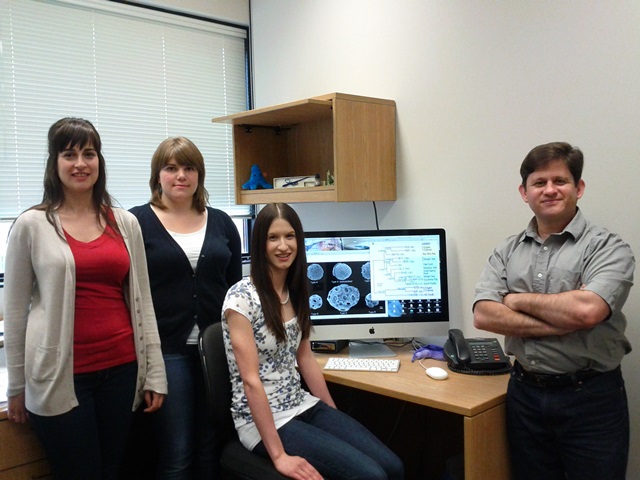
Left to right: Maria Aguilar, Emily Herman, Mary Klute and Joel Dacks
The White Cliffs of Dover are a famous landmark along the southern coast of England at its closest point to continental Europe. But what can these striking geographical structures teach us about human health? More than we yet know, according to researchers at the Faculty of Medicine & Dentistry who were part of a team that recently published its work in the prestigious, peer-reviewed journal Nature.
The celebrated cliffs are made of a white substance covering a type of alga called Emiliania huxleyi. Ehux cells are only six one-thousandths of a millimetre in size but the algae can undergo explosive population growth, or blooms, that may be hundreds of thousands of kilometres across. Some blooms, like those at Dover, are so large that they are visible from space. Ehux plays an important role in global carbon cycles, climate change and weather patterns. Its genome was recently sequenced by a research team led by Betsy Read (California State University San Marcos) and the U.S. Department of Energy Joint Genome Institute, and that included U of A Department of Cell Biology graduate students Mary Klute and Emily Herman, post-doctoral fellow Maria Aguilar, and their supervisor Joel Dacks.
From a health perspective, the genome sequence of Ehux is an important source of information for labs trying to understand cell biology, including the Dacks lab's comparative work on the machinery that transports material around our cells. This knowledge has already led to the identification of cellular components that researchers didn't know existed.
"Our lab studies this machinery in other diverse organisms in order to understand how it works and how it evolved in humans," said Dacks, explaining the importance of such basic scientific research and its potential implications for human health. "This same system in humans, when it goes wrong, causes cancer, Alzheimer's, Parkinson's and other neurodegenerative disorders."
The paper addresses a mystery about the alga's ability to survive in diverse oceanic environments, in some cases where other algae cannot. It turns out that what researchers thought was one species of alga is actually a collection. By sequencing not one strain of Ehux, but 13 from various global locations and using sophisticated computation approaches, "Mary figured out that these 13 strains fall into three different groups with worldwide distributions," said Dacks. The team found that these different organisms share a core of genes. However, many of their differing metabolic capacities are explained by genes shared by some, but not all. This phenomenon of a 'pan-genome' is commonly seen in bacteria, but this is the first reported example from algae.
The Dacks lab became involved with the enormous 75-person team through its interest in the cell biological machinery of Ehux. As the project moved forward, the lab was increasingly called upon to help answer certain questions because of its expertise in molecular evolution. Aguilar came to the project later, bringing a new set of skills and knowledge to complete a final experiment required by one of the reviewers.
Klute points out that publishing in such a prestigious journal speaks to the quality of undergraduate research opportunities at the U of A since both she and Herman began their work on the project four years ago when they were still undergrads. "It's really exciting for us to have started that work as summer students and have it end up in a journal such as Nature," she said. In fact, it is already the pair's second publication in Nature in the Dacks lab. Their first paper in the renowned journal came in December 2012 - a separate genome project that provided insight into the evolution of photosynthesis.
The project received funding from Alberta Innovates - Technology Futures and the Natural Sciences and Engineering Research Council of Canada (NSERC). Joel Dacks is Canada Research Chair in Evolutionary Cell Biology.